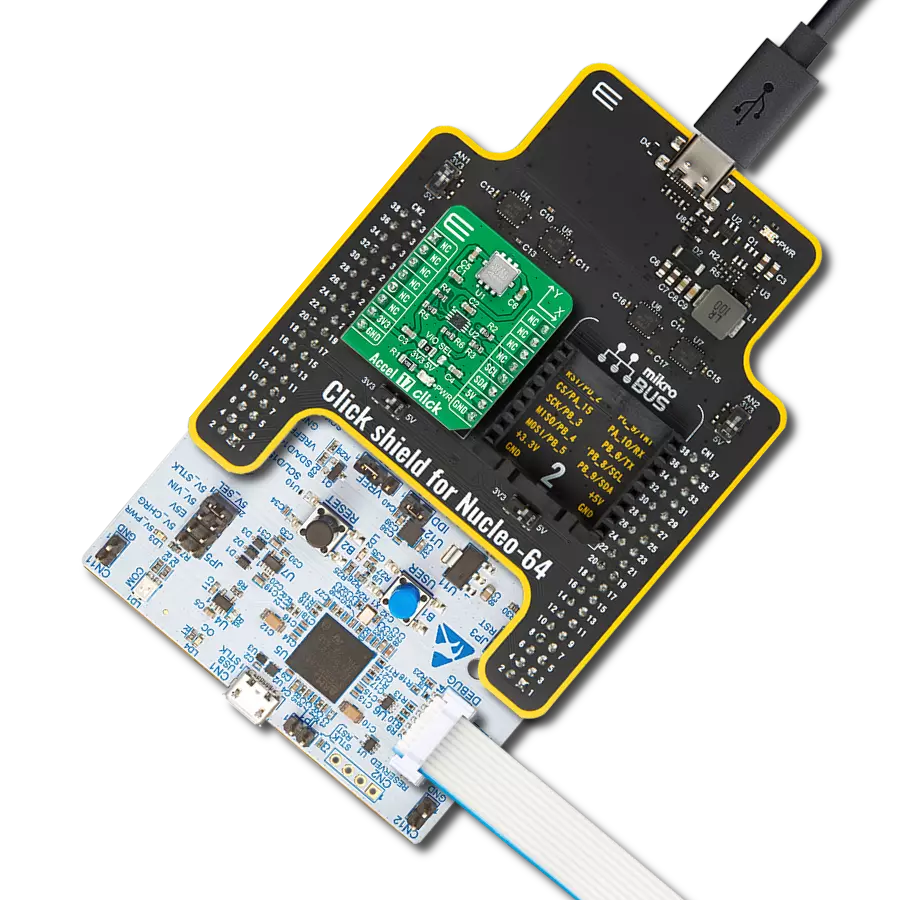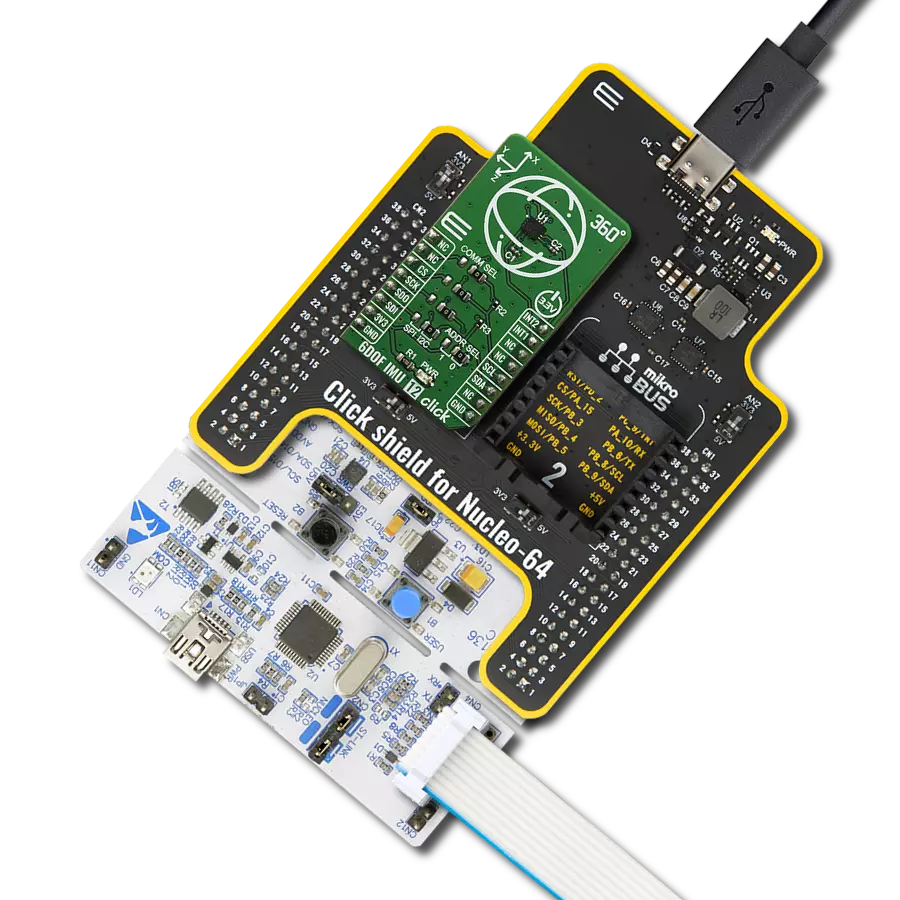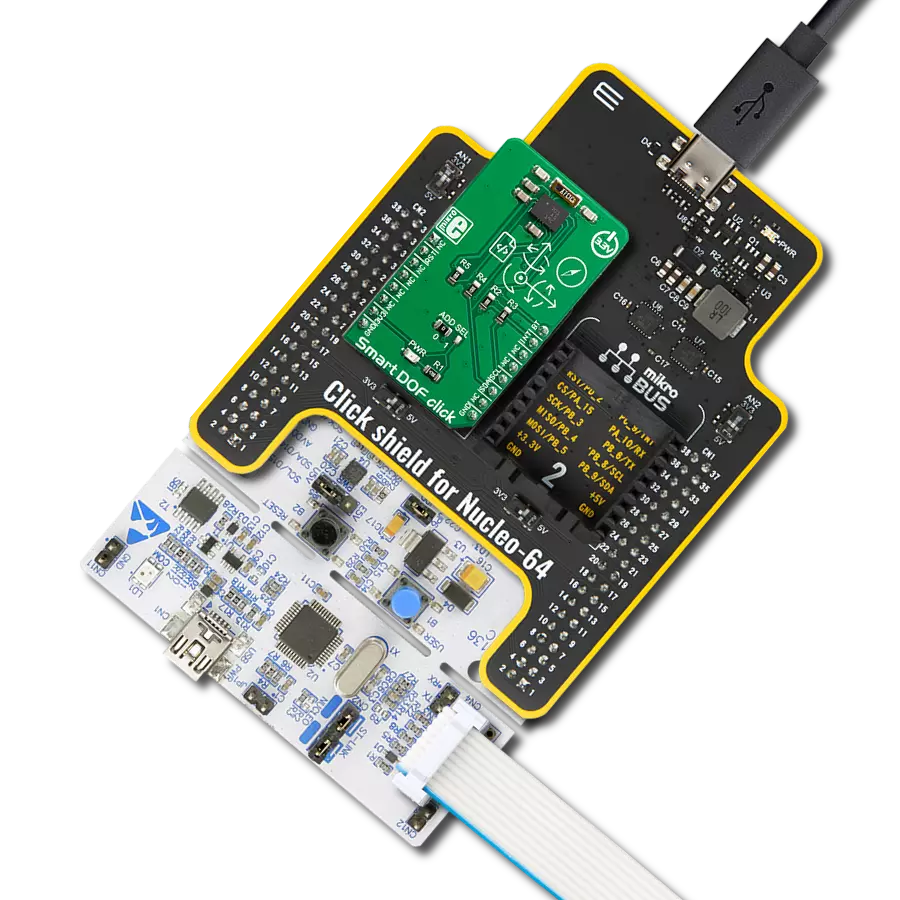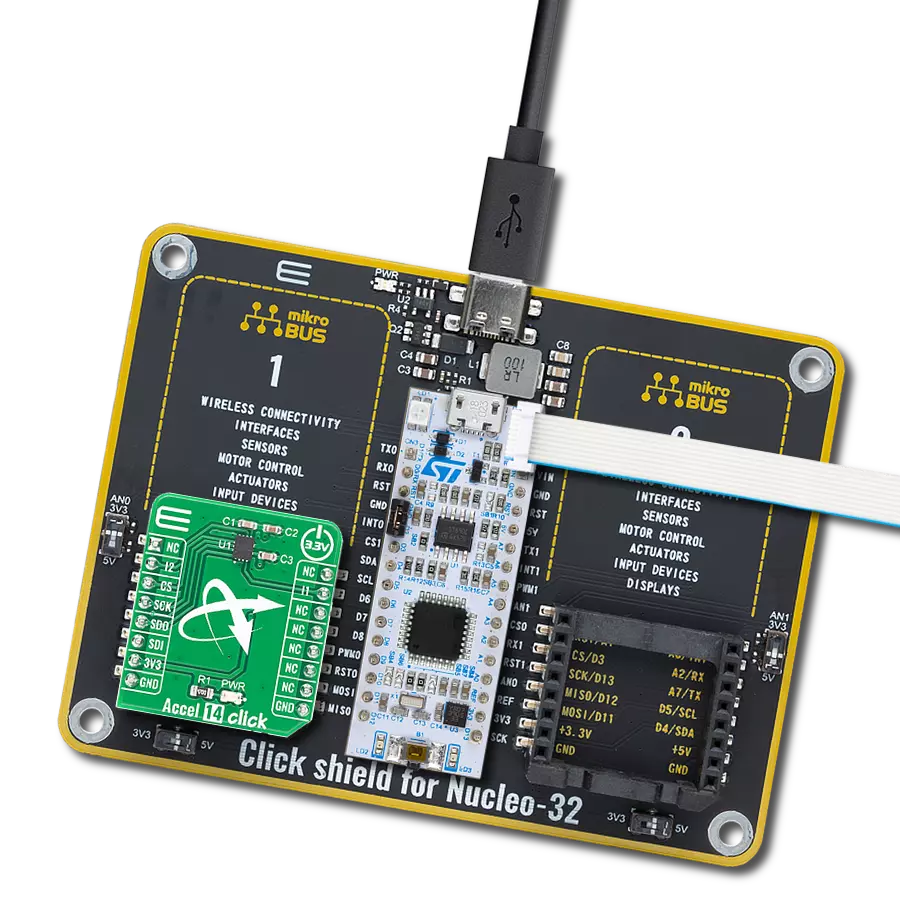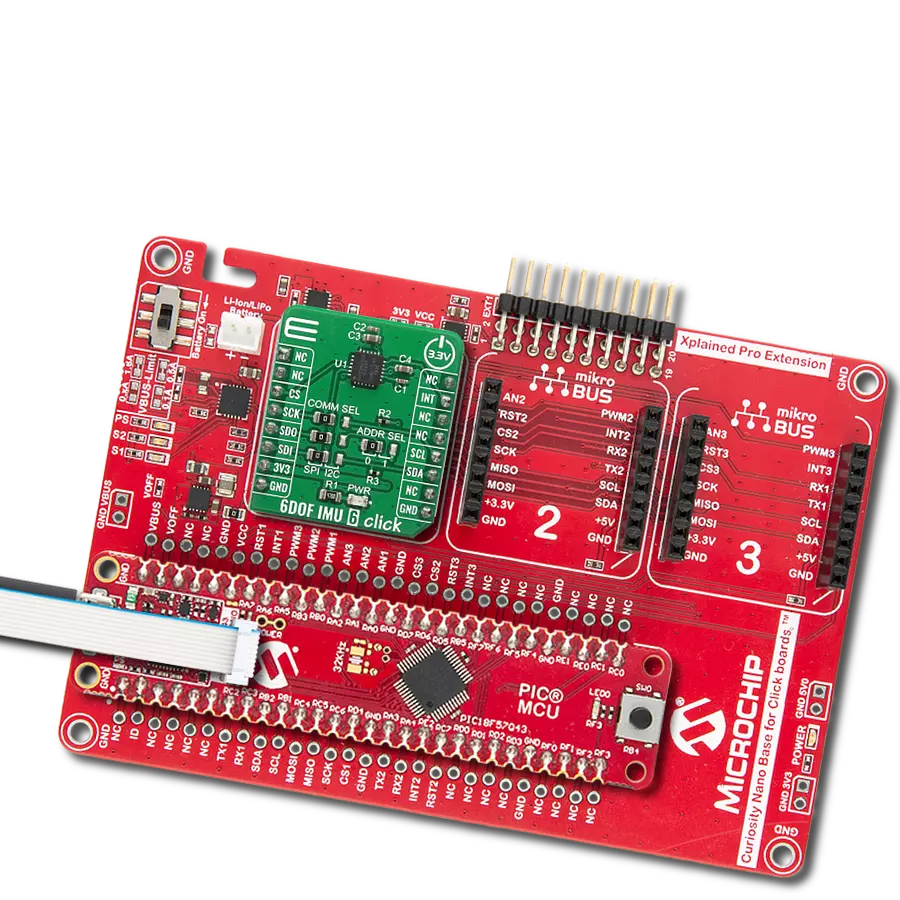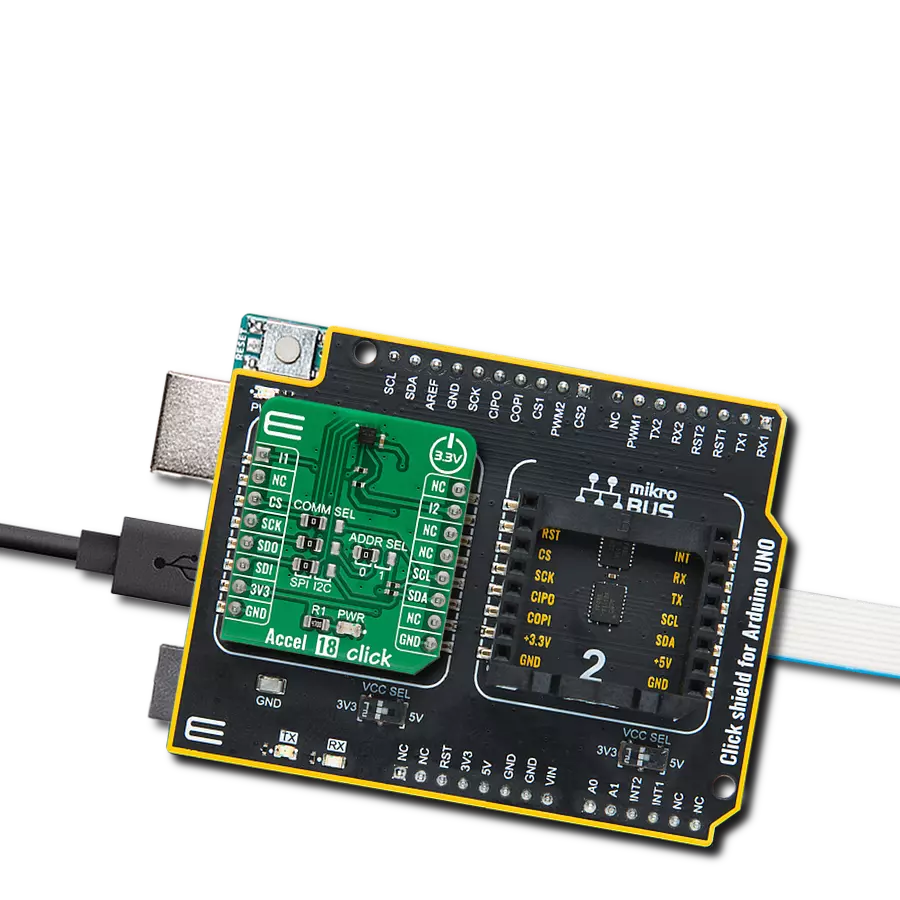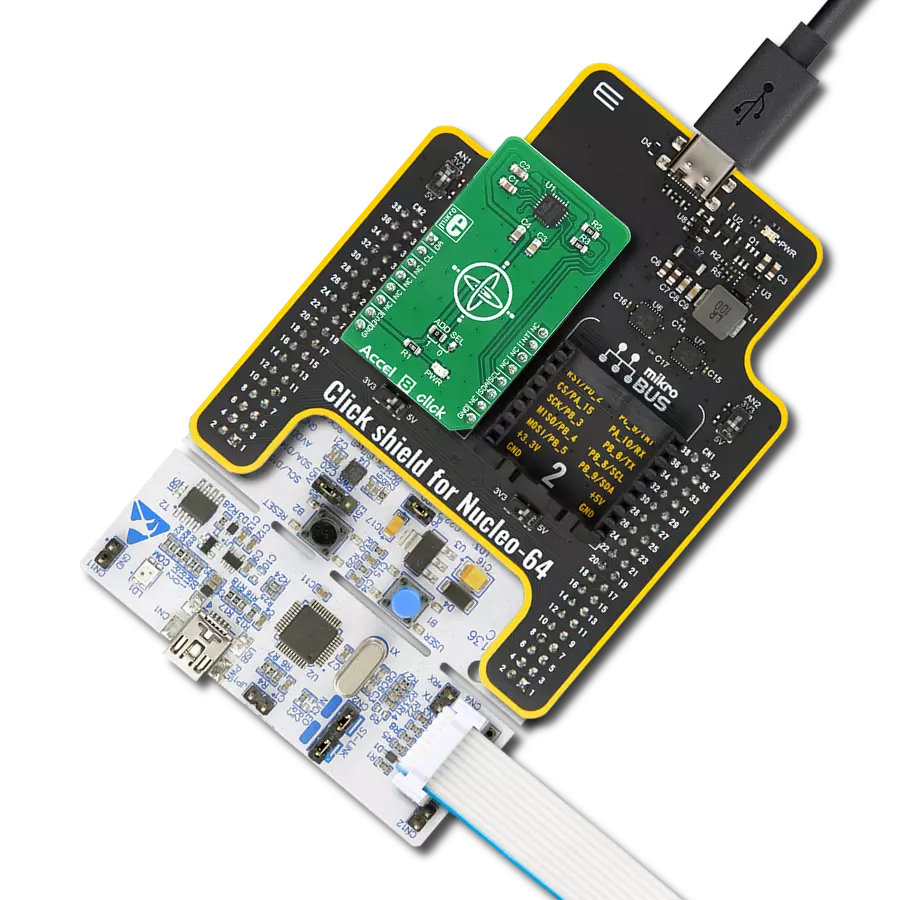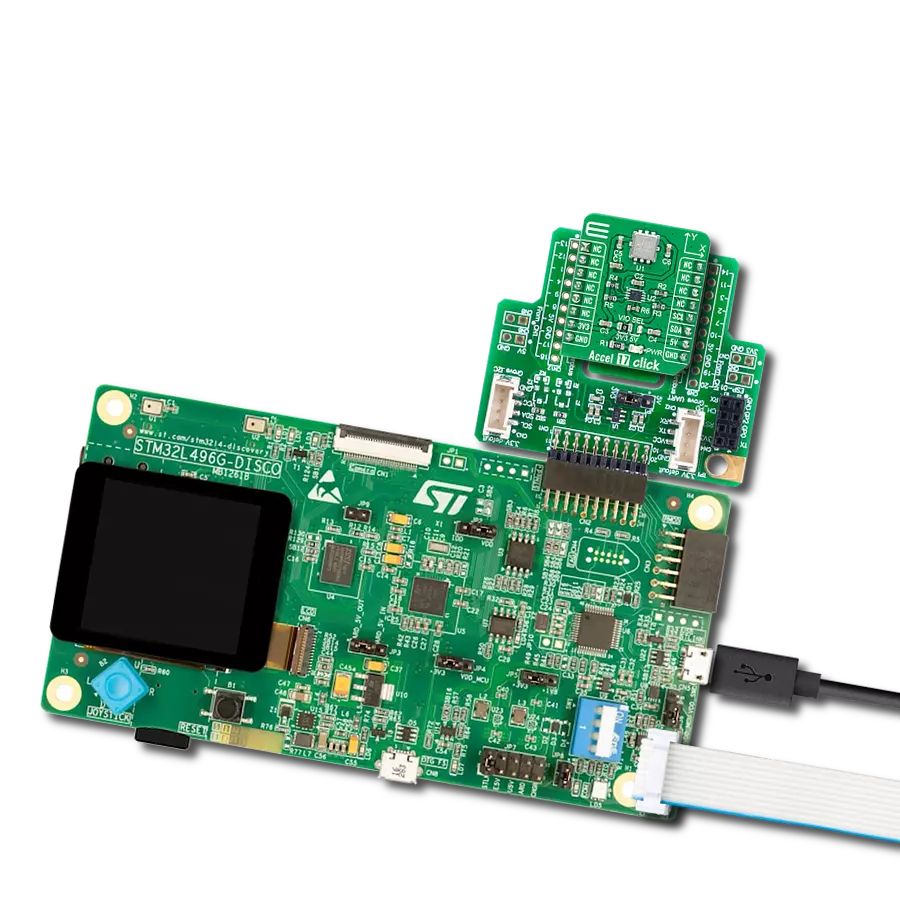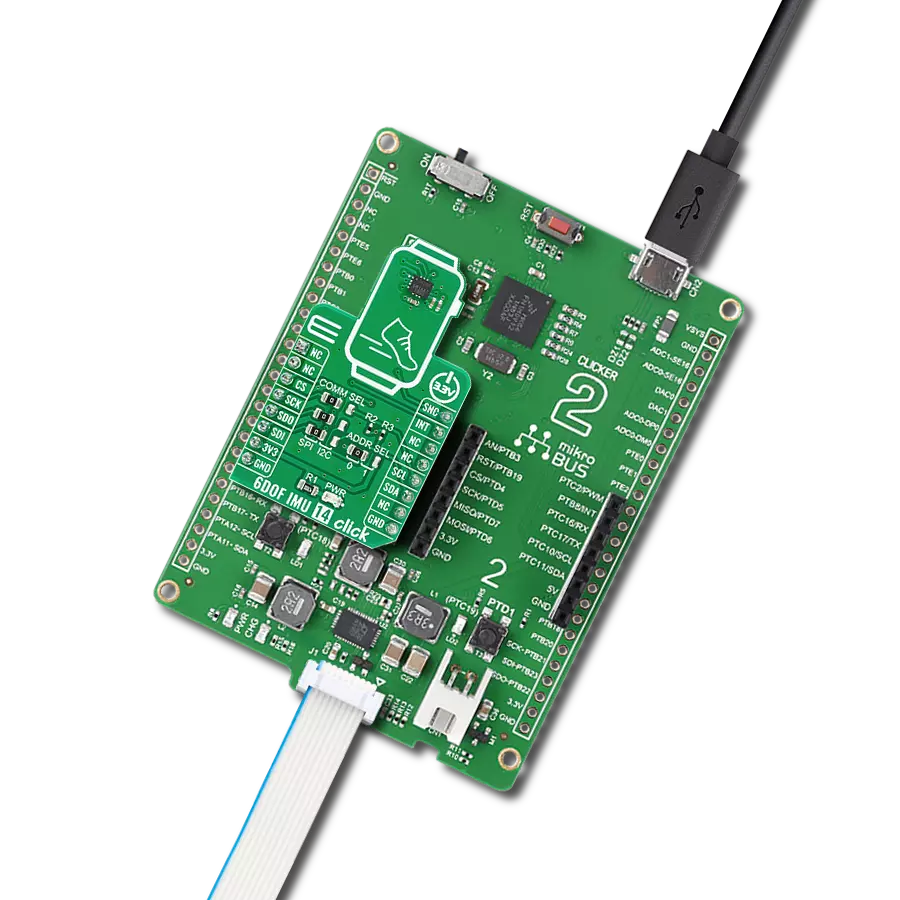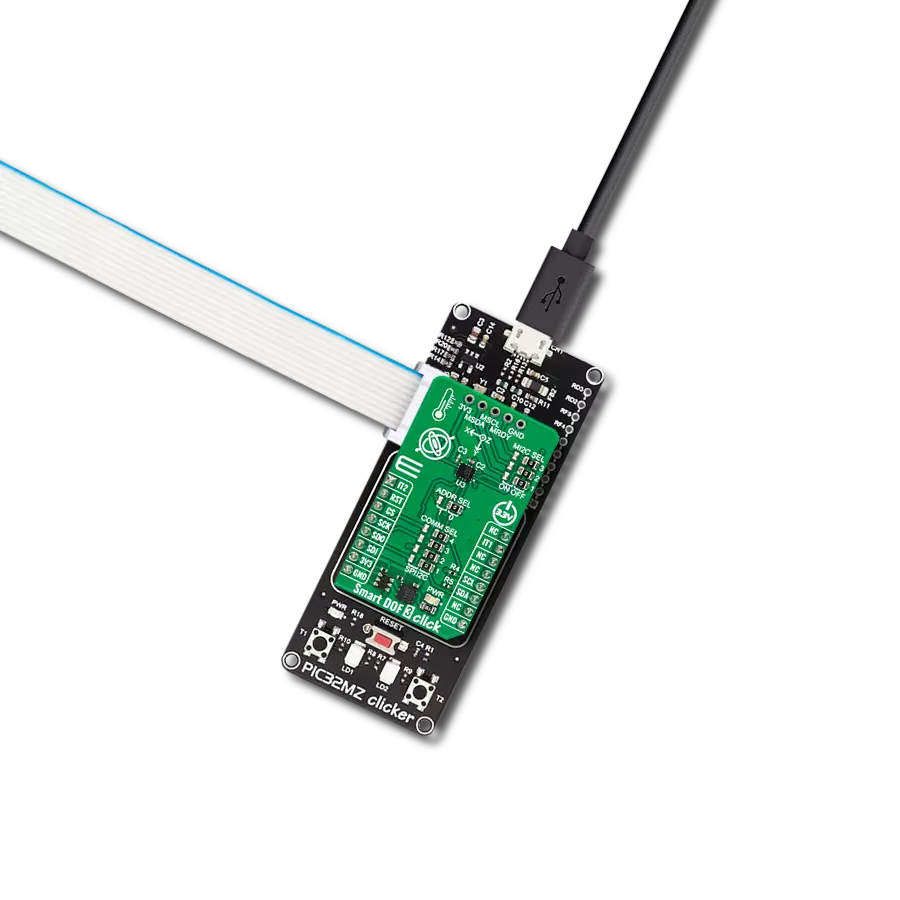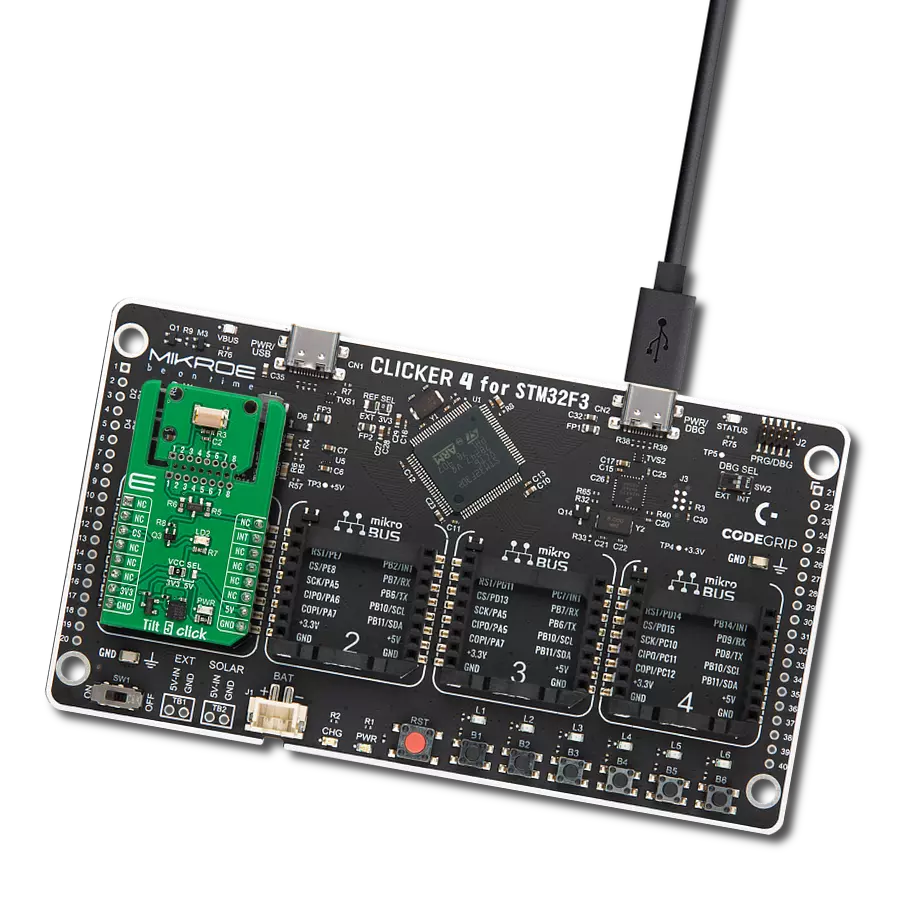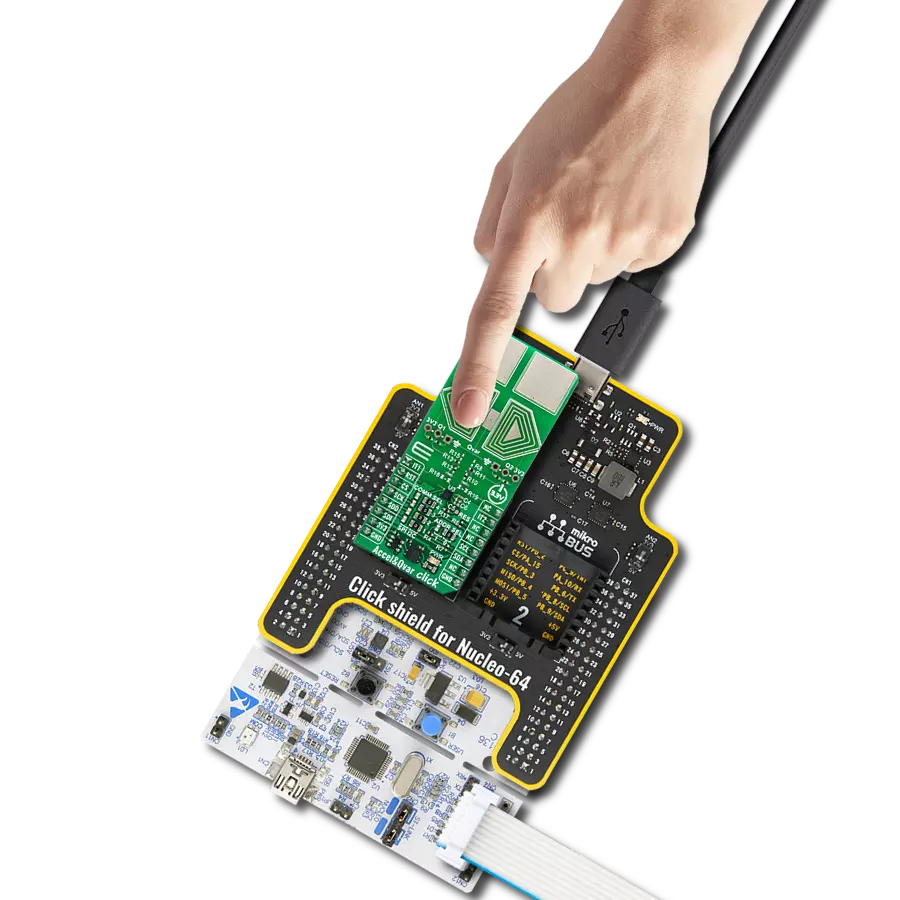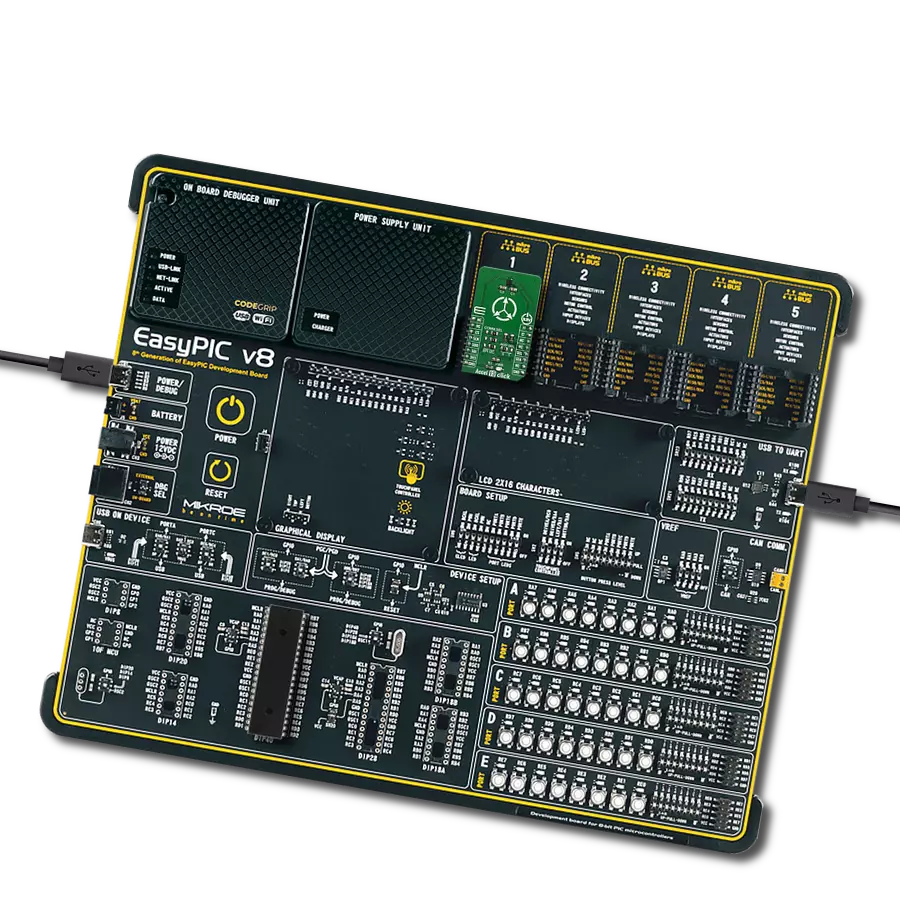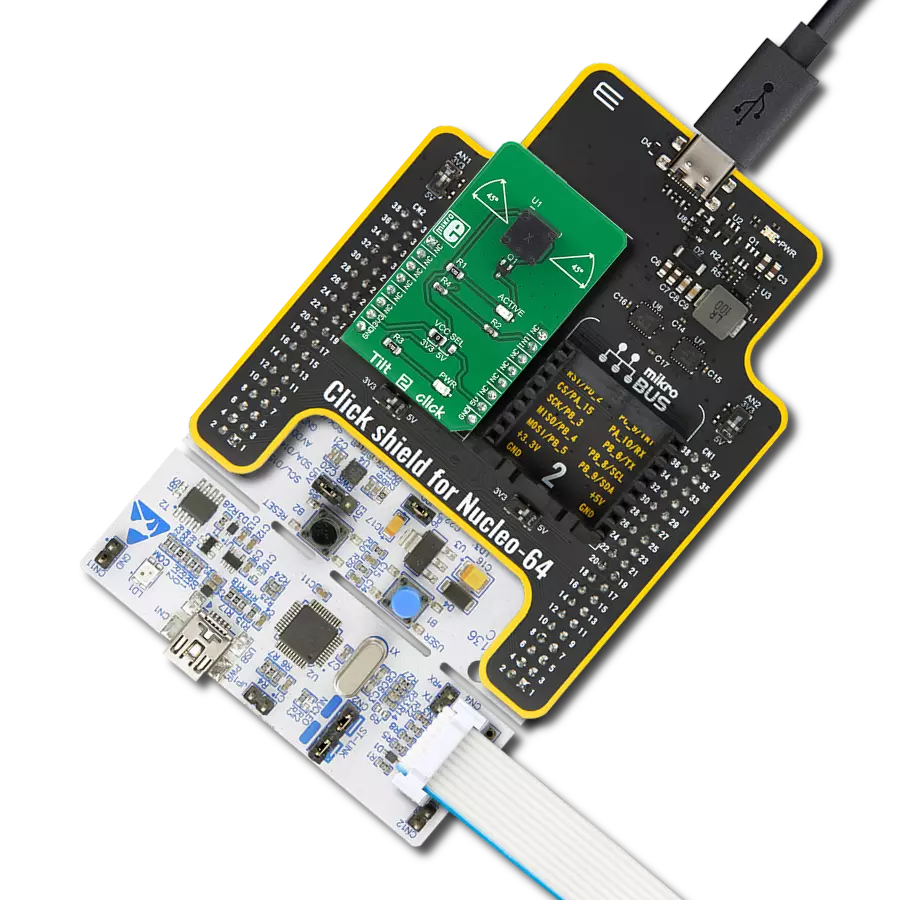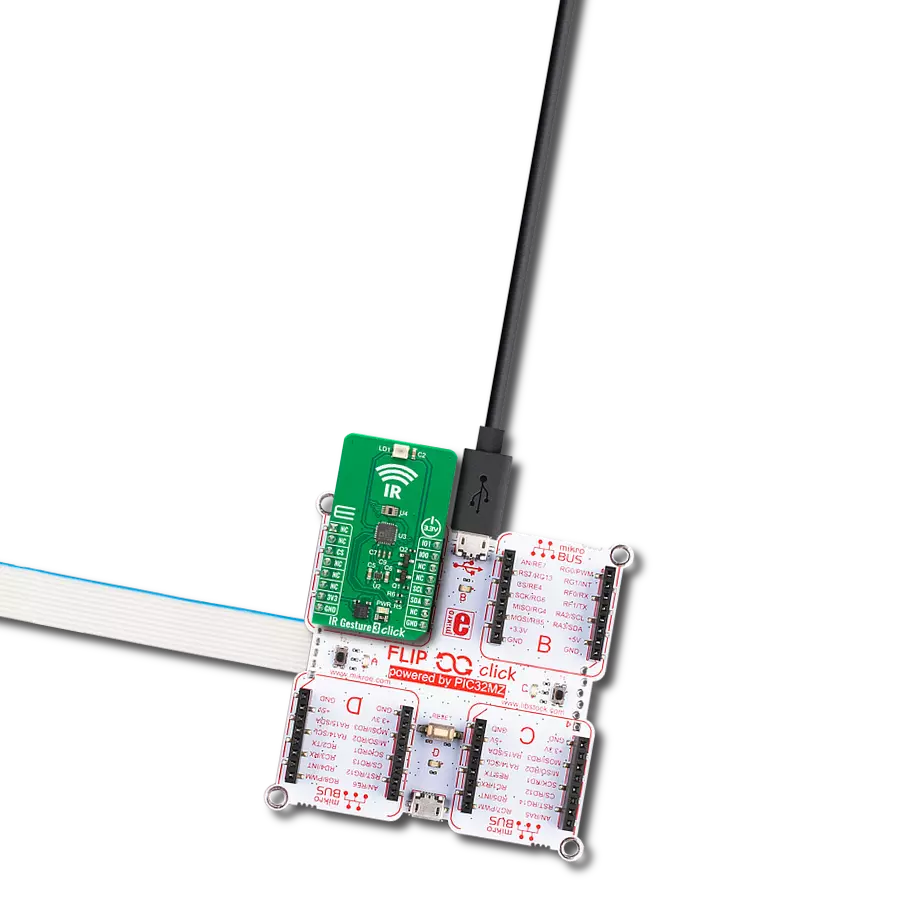Integrate three-axis accelerometer into your solution and unlock accurate and reliable motion sensing – seize the opportunity now!
A
A
Hardware Overview
How does it work?
Accel 2 Click is based on the LIS3DSH, a highly reliable digital triaxial acceleration from STMicroelectronics, with an embedded state machine that can be programmed to implement autonomous applications. The LIS3DSH is highly configurable with a programmable acceleration range of ±2g, ±4g, ±6g, ±8g, or ±16g, capable of measuring accelerations with selectable output data rates from 3.125Hz up to 1.6kHz. It supports high-performance and low-power operating modes, allowing maximum flexibility to meet the resolution and power needs of various motion control use cases. The LIS3DSH has an integrated first-in, first-out (FIFO) buffer for each of the three output channels, X, Y, and Z, allowing the user to store data to limit intervention by the host
processor. FIFO allows consistent power saving for the system since the host MCU does not need to poll data continuously from the sensor. Still, it can wake up only when needed and burst the essential data from the FIFO. Accel 2 Click allows the use of both I2C and SPI interfaces with a maximum frequency of 400kHz for I2C and 10MHz for SPI communication. The selection can be made by positioning SMD jumpers labeled SEL COMM in an appropriate position. Note that all the jumpers' positions must be on the same side, or the Click board™ may become unresponsive. While the I2C interface is selected, the LIS3DSH allows choosing the least significant bit (LSB) of its I2C slave address using the SMD jumper labeled I2C ADD. In addition to communication pins, this
board also possesses an additional interrupt pin, routed to the INT pin on the mikroBUS™ socket, indicating when a new set of measured acceleration data is available, simplifying data synchronization in the digital system that uses the device. Also, the user-defined programs can distinguish movement patterns like shake and double shake, face up and face down, turn and double turn, and then activate an interrupt upon execution. This Click board™ can be operated only with a 3.3V logic voltage level. The board must perform appropriate logic voltage level conversion before using MCUs with different logic levels. Also, it comes equipped with a library containing functions and an example code that can be used as a reference for further development.
Features overview
Development board
UNI-DS v8 is a development board specially designed for the needs of rapid development of embedded applications. It supports a wide range of microcontrollers, such as different STM32, Kinetis, TIVA, CEC, MSP, PIC, dsPIC, PIC32, and AVR MCUs regardless of their number of pins, and a broad set of unique functions, such as the first-ever embedded debugger/programmer over WiFi. The development board is well organized and designed so that the end-user has all the necessary elements, such as switches, buttons, indicators, connectors, and others, in one place. Thanks to innovative manufacturing technology, UNI-DS v8 provides a fluid and immersive working experience, allowing access anywhere and under any
circumstances at any time. Each part of the UNI-DS v8 development board contains the components necessary for the most efficient operation of the same board. An advanced integrated CODEGRIP programmer/debugger module offers many valuable programming/debugging options, including support for JTAG, SWD, and SWO Trace (Single Wire Output)), and seamless integration with the Mikroe software environment. Besides, it also includes a clean and regulated power supply module for the development board. It can use a wide range of external power sources, including a battery, an external 12V power supply, and a power source via the USB Type-C (USB-C) connector. Communication options such as USB-UART, USB
HOST/DEVICE, CAN (on the MCU card, if supported), and Ethernet is also included. In addition, it also has the well-established mikroBUS™ standard, a standardized socket for the MCU card (SiBRAIN standard), and two display options for the TFT board line of products and character-based LCD. UNI-DS v8 is an integral part of the Mikroe ecosystem for rapid development. Natively supported by Mikroe software tools, it covers many aspects of prototyping and development thanks to a considerable number of different Click boards™ (over a thousand boards), the number of which is growing every day.
Microcontroller Overview
MCU Card / MCU
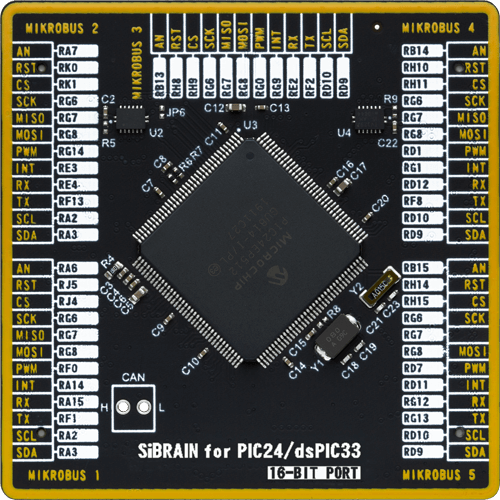
Type
8th Generation
Architecture
dsPIC
MCU Memory (KB)
512
Silicon Vendor
Microchip
Pin count
144
RAM (Bytes)
53248
Used MCU Pins
mikroBUS™ mapper
Take a closer look
Click board™ Schematic

Step by step
Project assembly
Software Support
Library Description
This library contains API for Accel2 Click driver.
Key functions:
accel2_check_id- Check Accel 2 IDaccel2_read_xaxis- Function read X axisaccel2_read_yaxis- Function read Y axis
Open Source
Code example
The complete application code and a ready-to-use project are available through the NECTO Studio Package Manager for direct installation in the NECTO Studio. The application code can also be found on the MIKROE GitHub account.
/*!
* \file
* \brief Accel2 Click example
*
* # Description
* This application is three-axis accelerometer which embeds.
*
* The demo application is composed of two sections :
*
* ## Application Init
* Initialization device. Check sensor ID and initialize Accel 2 Click.
*
* ## Application Task
* This is a example which demonstrates the use of Accel 2 Click board.
Measured coordinates (X,Y,Z) are being sent to the UART where you can track their changes.
*
* \author MikroE Team
*
*/
// ------------------------------------------------------------------- INCLUDES
#include "board.h"
#include "log.h"
#include "accel2.h"
// ------------------------------------------------------------------ VARIABLES
static accel2_t accel2;
static log_t logger;
// ------------------------------------------------------ APPLICATION FUNCTIONS
void application_init ( void )
{
log_cfg_t log_cfg;
accel2_cfg_t cfg;
uint8_t cfg_byte = 0;
/**
* Logger initialization.
* Default baud rate: 115200
* Default log level: LOG_LEVEL_DEBUG
* @note If USB_UART_RX and USB_UART_TX
* are defined as HAL_PIN_NC, you will
* need to define them manually for log to work.
* See @b LOG_MAP_USB_UART macro definition for detailed explanation.
*/
LOG_MAP_USB_UART( log_cfg );
log_init( &logger, &log_cfg );
log_info( &logger, "---- Application Init ----" );
// Click initialization.
accel2_cfg_setup( &cfg );
ACCEL2_MAP_MIKROBUS( cfg, MIKROBUS_1 );
accel2_init( &accel2, &cfg );
Delay_ms ( 100 );
accel2_setting( &accel2 );
Delay_ms ( 100 );
cfg_byte = accel2_check_id( &accel2 );
if ( cfg_byte )
{
log_info( &logger, "---- ID ERROR ----" );
for ( ; ; );
}
else
{
log_info( &logger, "---- ID OK ----" );
}
}
void application_task ( void )
{
int16_t value_x;
int16_t value_y;
int16_t value_z;
value_x = accel2_read_xaxis( &accel2 );
value_y = accel2_read_yaxis( &accel2 );
value_z = accel2_read_zaxis( &accel2 );
log_printf( &logger, "Axis X: %d\r\n", value_x );
log_printf( &logger, "Axis Y: %d\r\n", value_y );
log_printf( &logger, "Axis Z: %d\r\n", value_z );
log_printf( &logger, "-------------------------------\r\n" );
Delay_ms ( 500 );
}
int main ( void )
{
/* Do not remove this line or clock might not be set correctly. */
#ifdef PREINIT_SUPPORTED
preinit();
#endif
application_init( );
for ( ; ; )
{
application_task( );
}
return 0;
}
// ------------------------------------------------------------------------ END
Additional Support
Resources
Category:Motion

















